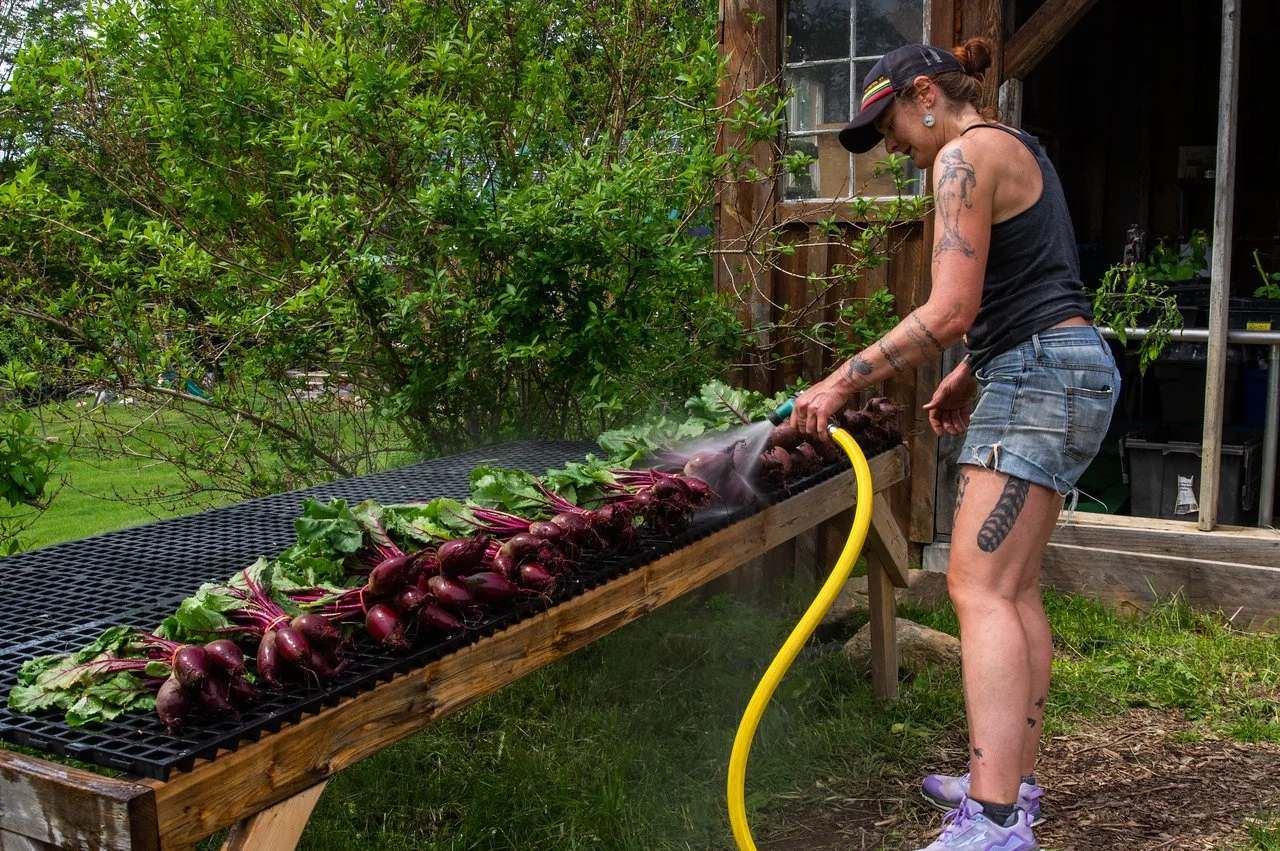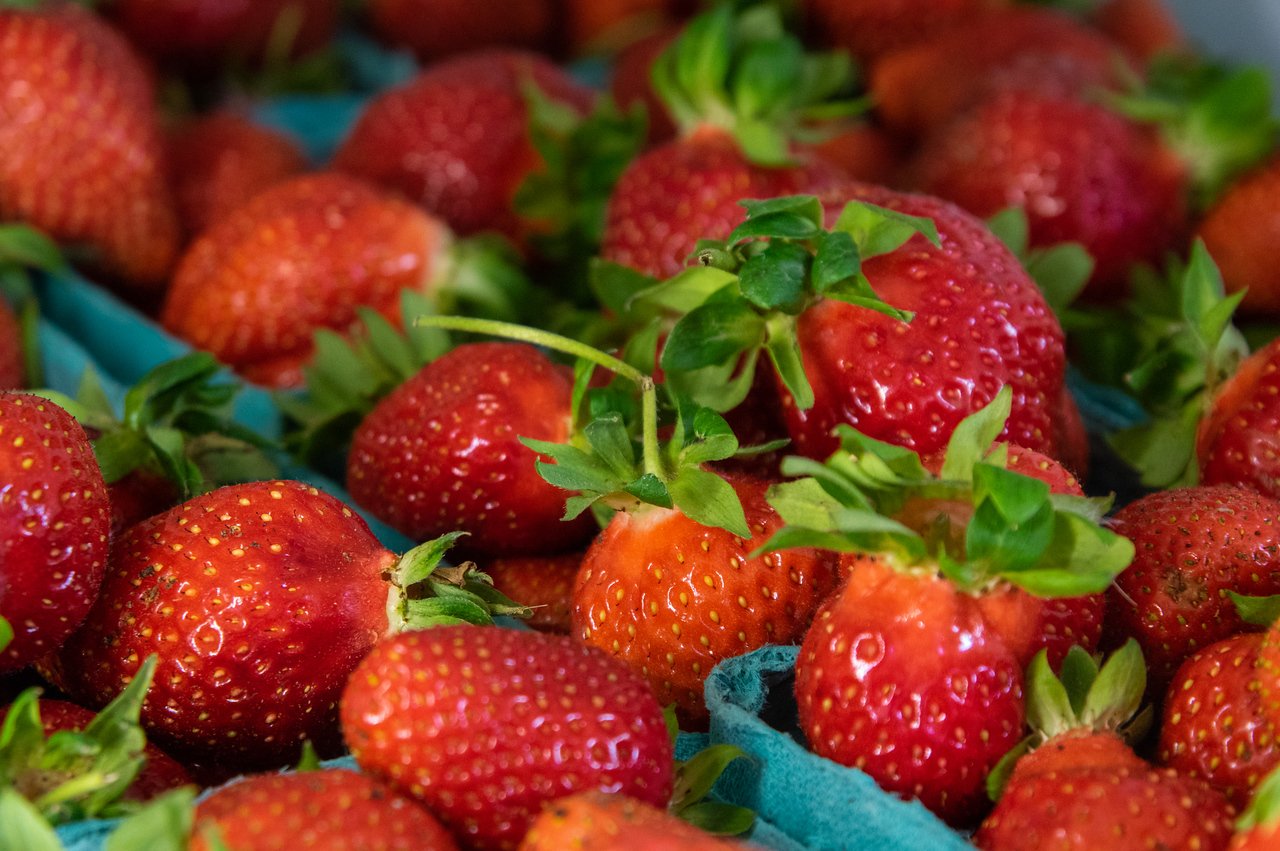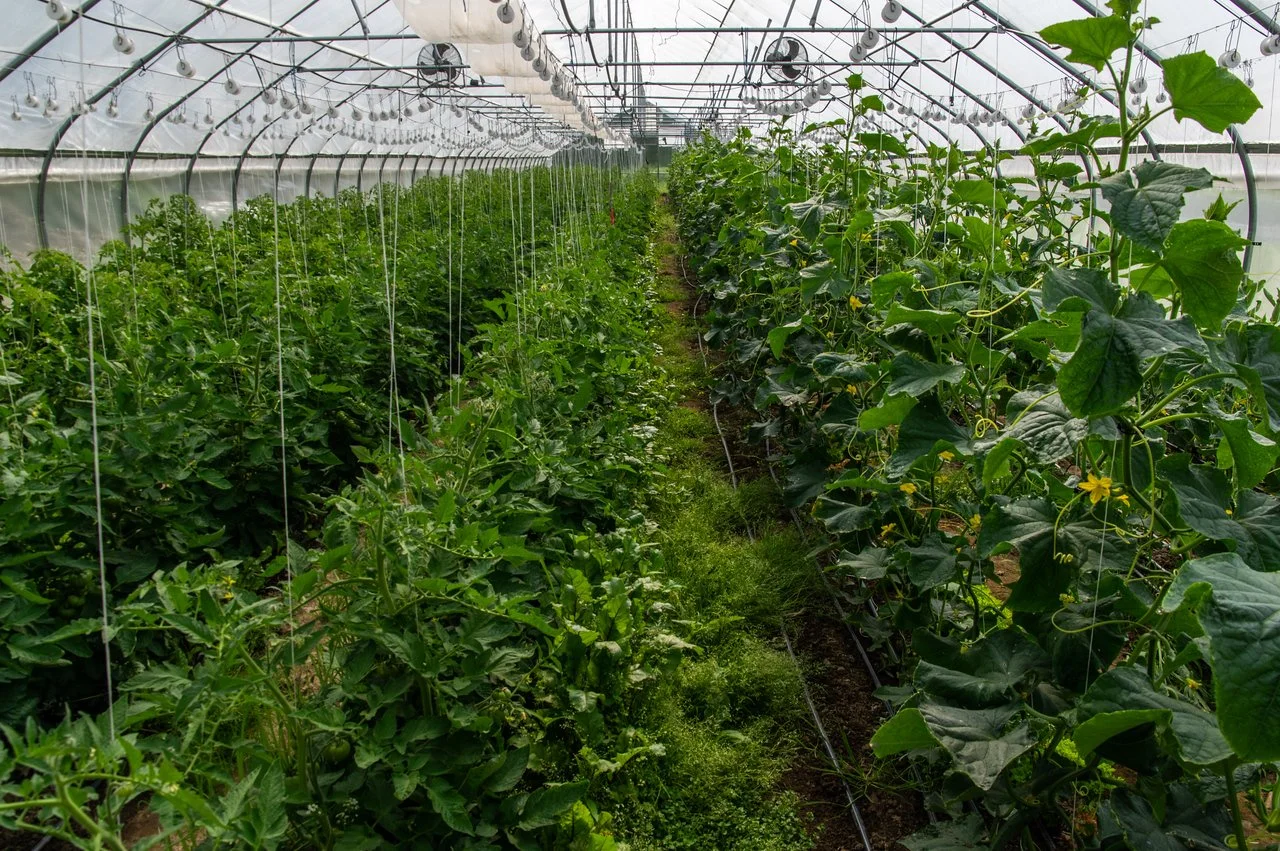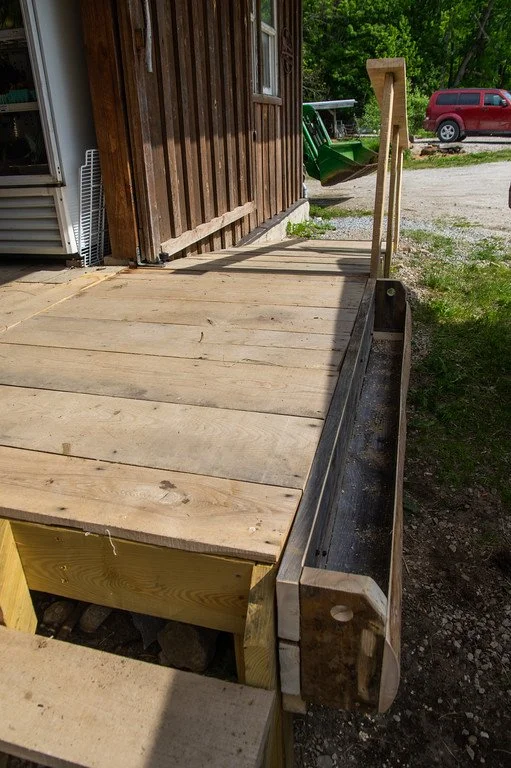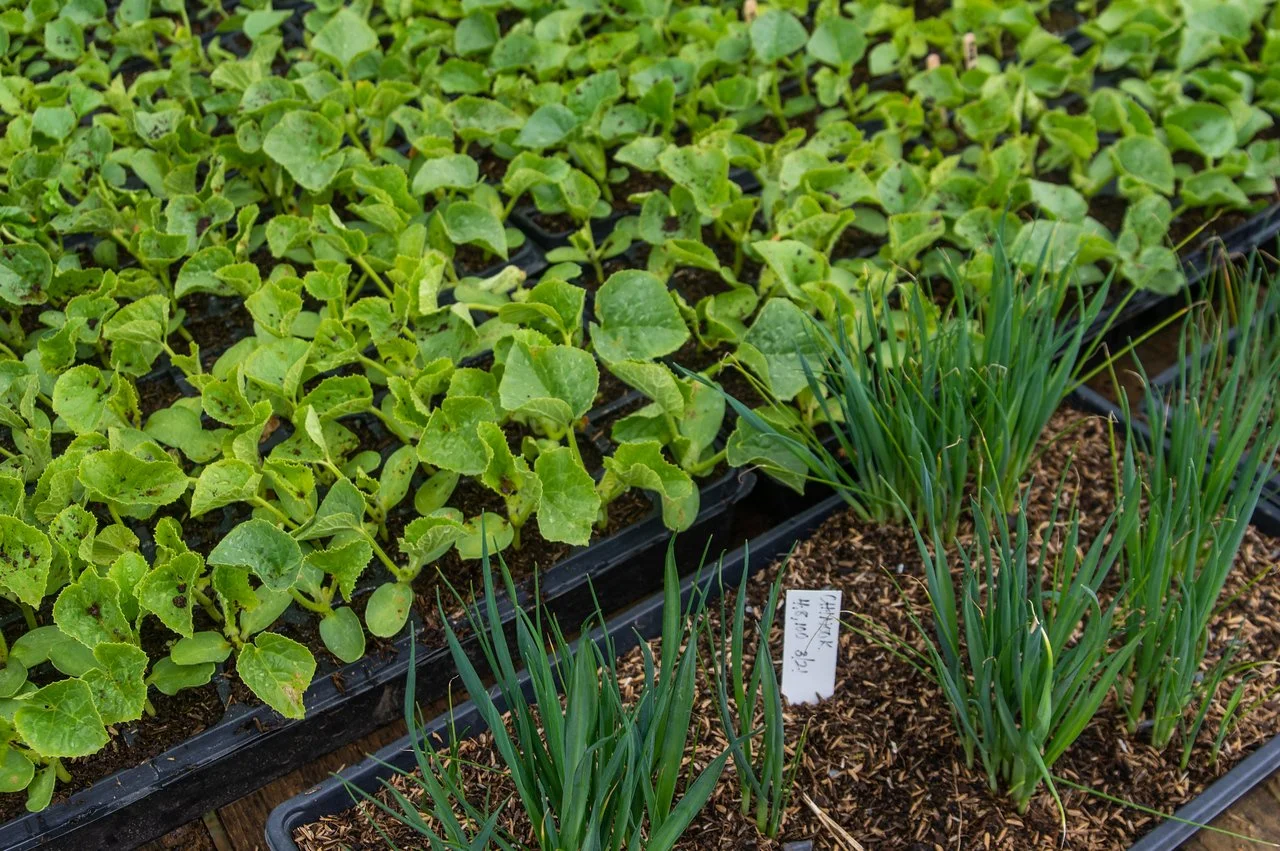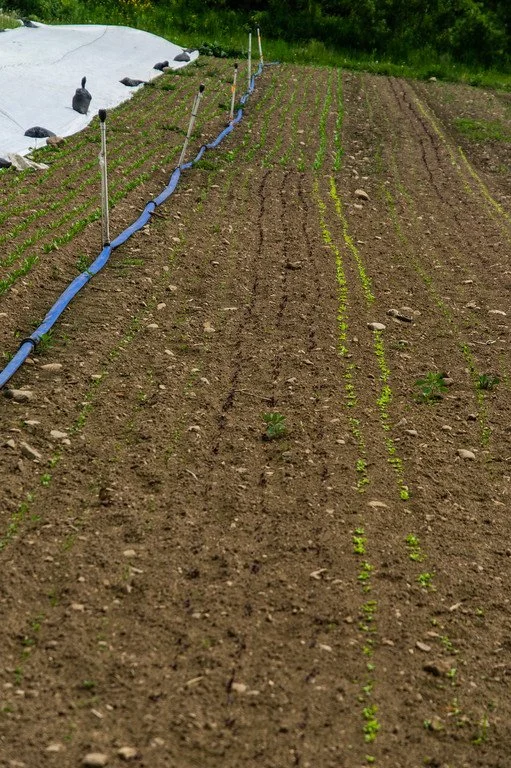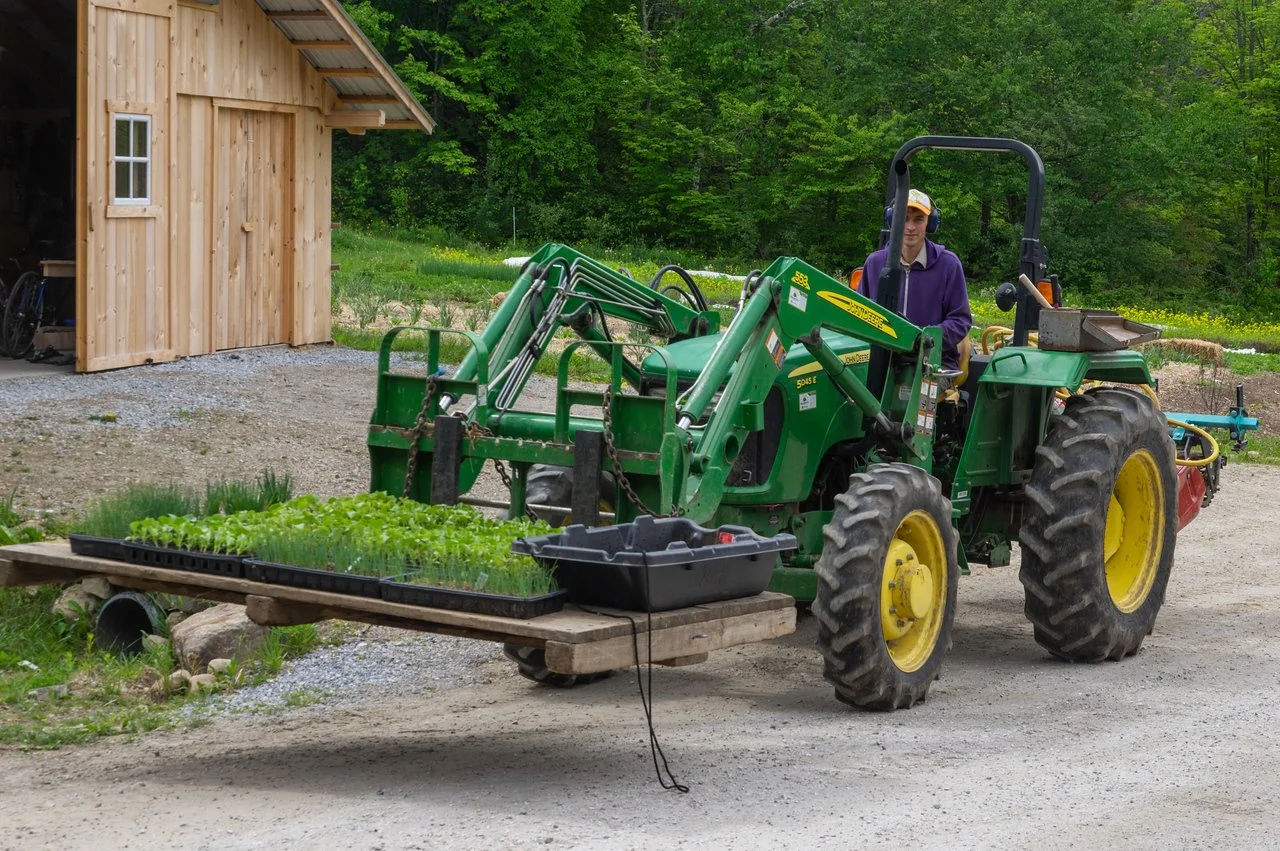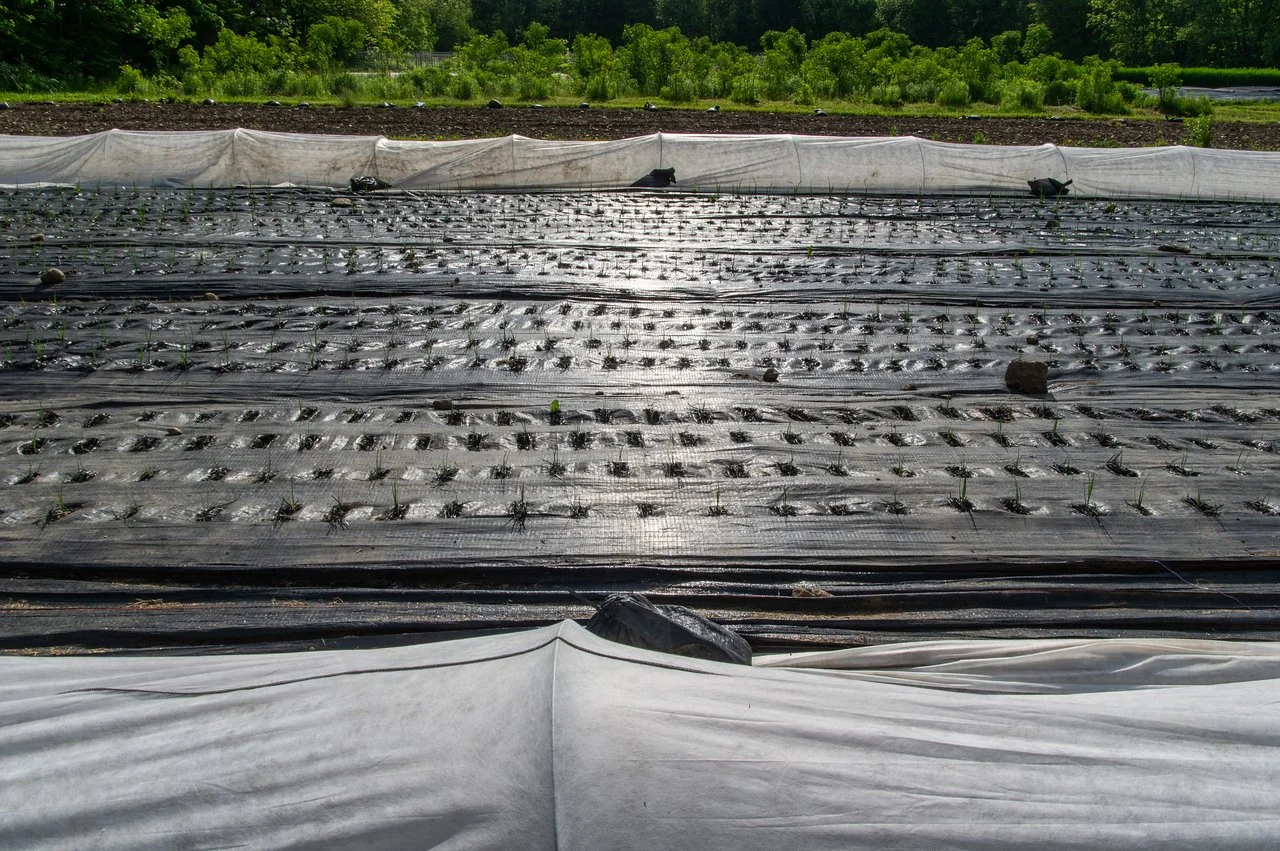3rd Week of the Summer CSA season: Week of June 20th
they are here! photo by Adam Ford
Galen spraying beets, photo by Adam Ford
close up of those gorgeous fresh beets, photo by Adam Ford
CSA Balance Due
If you haven’t already paid, your balance is due. You can pay online through your account (with a card or e-check ACH payment), mail a check to Evening Song Farm 48 Nice Road, Cuttingsville VT 05738, leave a check or cash in the CSA cash box at the barn, send money with Venom @eveningsongcsa, or use EBT. It’s very cool to pay in smaller chunks, just let us know what your payment plan is.
chive flowers, photo by Adam Ford
daisy, photo by Adam Ford
This Week’s Availability
This week we will have red radish bunches, salad turnips, fresh red beets with greens, fresh yellow beets with greens, fresh carrots with tops, rainbow chard, baby lettuce, baby kale, arugula, lacinato kale bunches, baby bok choi, spinach, rhubarb, winter chioggia beets, fresh oregano bunches, scallions, and strawberries!!
(Strawberries will still have a limit of 1 pint per share this week, this year they aren’t as vigorous yet as last year. And also, strawberries are a double item, as in 1 pint= 2 CSA items.)
How come there is a limit on strawberries, but I saw some of your strawberries for sale at my local store this weekend? Excellent question: We have to harvest the strawberries every few days to keep up with their ripening. And when we pack the last of the weekly CSA bags on Friday, we sometimes have some extra pints after those bags go out that we offer to local outlets, since they won’t hold well over the weekend for the next week of CSA distribution. This week it wasn’t enough extra to have bumped up the weekly CSA limit to 2 pints for each CSA share, but fingers crossed that may be able to happen this year.
Ordering closes at noon on Tuesdays for Wednesday bags, and at midnight on Wednesdays for Friday bags.
You do not need to fill out the form if you plan to come to the barn on Tuesdays, Wednesdays or Thursdays to pick out your items yourself.
garlic, photo by Adam Ford
pea shoots, photo by Adam Ford
little drops of June heaven, photo by Adam Ford
Farm News
This week the team kept trellising tomatoes and cucumbers, weeded several crops, transplanted melons, later brassicas, outdoor cucumbers, and also got the whole pick-your-own flower garden in! It is always so fun to finally get that area planted, and imagine all the later summer beautiful that will greet us next to the barn.
Last week I wrote a long newsletter about the climate change stories cohort I am participating in, and the research consolidated by Action Circles about the current public narratives around farms and climate change. This week I will share one of the new message frames they are trying to get out into the world about farming and climate. (The message frame is in bold, the unbolded words are their explanation for that message frame, and the italics are my own thoughts.)
Farms produce more than food.
Farmers are integral to their communities, the health of the land, and our future landscape.
This idea is most apparent to me in regions where farmland has been mostly lost. We are lucky in Vermont that our productive landscapes have persisted into the 21st century. When I have lived in more densely populated areas, there are few, if any, farms left able to produce food for that region, and it limits that community’s access to regionally sourced fresh food. Urban farms are doing incredible work producing food for their communities and providing educational spaces to reconnect eaters to the earth, but most dense areas need much more production than current urban farming output can keep up with. Working landscapes also provide spaces for the earth be the earth… with grass and dirt and gardens to soak up rains instead of having that water runoff into storm drains and into municipal water treatment facilities. Working landscapes provide habitat for wildlife and food sources for pollinators. Maintaining land in agricultural production provides much more for the landscape than just the food it produces.
Farm viability is more than economics. Farm viability is rooted in community and ecology.
We have felt this reality from the beginning of our adventure as farmers. We started a CSA program on friends’ land in Pennsylvania, and their farm already had a strong community connection and developed systems that supported the local ecology. We were able to start a vegetable business and be viable and economically successful in the first year because of that farm’s connection to community and local ecology. And we also attribute our ability to start a farm in Vermont to this community’s eager welcome of a new farm in the area. We could not have started, developed, and expanded this operation without our community connections. And the more we stay involved and engaged in our wider community beyond our role as food producers, the more we get the message from the community that this farm is important to them. As a community, we are all (all= farmers and eaters together) taking care of this production space because it matters to maintain land in this way to this region.
A farmer's knowledge of the land and its ecological cycles is what makes a farm sustainable and successful.
And let’s be real… the land is the actual teacher in this scenario. I have heard that the best farmers are the best listeners. And if we are able to listen to the land and the plants and the critters who share this space with us, we can guide our farm production in a way that is most supportive of the local ecology. Some of you may think, “listen to the land, you guys sound a little out there!” but listening takes so many forms. The plants, animals, and microorganisms of this land can’t speak to us, but are affected by our management methods. Over years, we’ve made time to observe closely and pay attention: to the changes in species over time, to water movement and infiltration, to the texture of soil, to the growth of plants under different soil and climate conditions. Close observation is one of the more essential parts of what we do.
The business of farming is to honor the cycles of ecology rather than the extractive nature of capitalist economics.
Truly. It’s remarkable to me how giving the local ecology is. With the right care and intentions, it is a real gift to accept all the bounty that comes from land management. When the priorities of capitalism intersect with our farming practices, we notice. In the early years of starting our farm, when we were strained by infrastructure building and limited by lack of experience, our focus was more limited to making sure our farm could pay its bills, at the expense of seeing our farm’s place within an ecological system. Over just a few years, we began to notice problems sprout up on our farm: an increase in weed and pest species, decreasing quality of the soil structure. Through a lot of observation and problem solving, we’ve shifted our growing practices and focus to manage this farm as a part of the broader ecological community. In our current economic structure, managing the flow of money through a farm system is essential, but so is managing the flow of water and nutrients through the soil that allow the whole farm ecosystem to continue.
Strong local food systems create climate resilience for all.
As a production farmer, I want as many other viable ecologically-minded production farms in operation because it builds a stronger foundation for a healthy climate.
So there you go… 1 of their 5 new message frames. It’s fun to think about how agricultural production is definitely more than the food we grow. My own understanding of that reality has grown a lot over the years… our first year in production I didn’t see any value in doing anything besides, seeds in the ground, weed, harvest, wash, sell, do it again, because no one was paying me to plant flowers for pollinators, watching my cover crops grow didn’t get me health insurance, leaving wild spaces for biodiversity didn’t pay my car insurance, putting up bat boxes didn’t cover student loans, etc. But over the years it’s apparent that the earth is actually paying me to do all that, just with a different currency than we use with human society: In return for the care in land management, we have healthy soils for our farm business, a happy and badass farm crew, a beautiful place to raise our kiddos, shade to enjoy on a sunny day, pollinators to assistance our veggie growing efforts, baby birds to watch hatch and grow up, hummingbirds to marvel at, a supportive CSA community, to name just a few of the ways we see value in the bigger picture of farming. And hoping those efforts are weaving into a future of climate resilience.
Have a great week,
-ESF Team: Ryan, Kara, Molly, Cindy, Galen, Katie, K2, Taylor, Vanessa, and Bryan (and Sky and Soraya)
Weekly Recipe
tomatoes and cukes going wild, photo by Adam Ford
soon to be a little flower box by the entrance, photo by Adam Ford
melons and leeks heading out to be tp-ed, photo by Adam Ford
Galen spraying bins, photo by Adam Ford
next round of baby lettuce will be ready before we know it, photo by Adam Ford
moving them on the large pallet to the field, photo by Adam Ford
Lily and Vanessa laying out the transplants, photo by Adam Ford
van getting loaded up, photo by Adam Ford
leek rows in between melons tucked in under row cover, photo by Adam Ford
harvesting, photo by Adam Ford
loading up that harvest of baby lettuce and other greens, photo by Adam Ford
Molly, photo by Adam Ford
yellow beets are almost ready, photo by Adam Ford
nasturtium, photo by Adam Ford
hey there, barn, photo by Adam Ford
Moth on a cucumber vine photo by Adam Ford
my brother is on a roll repairing areas that needed larger overhangs, photo by Adam Ford
my brother made a little table for his yard with some old lumber and tables legs from a broken old picnic table, photo by Adam Ford
stacks of field greens waiting for Vanessa to wash,, photo by Adam Ford.
looking up from the barn field, photo by Adam Ford
zucchini flower, photo by Adam Ford
outdoor peppers, photo by Adam Ford
Phacelia flower. We planted this as a cover crop, along with oats and peas, to provide pollinator habitat. photo by Adam Ford
excluder resting on a hive box, photo by Adam Ford
sometimes it takes a fair bit of head scratching to make the repairs the best way, photo by Adam Ford
these sweet baby birds successfully hatched on the ground next to one of the fields… it’s a miracle since it was very unprotected, photo by Adam Ford


